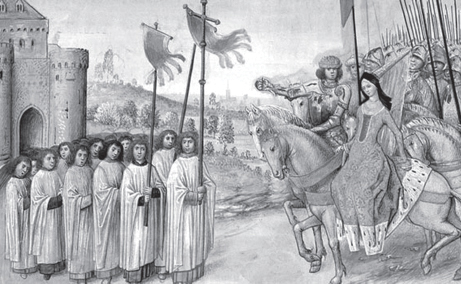

Wow. Where to start. Let’s just say that Isabella didn’t have an easy time of it.
For daring to stand up for herself, to challenge the status quo, to assert herself and not simply be, as was expected, a wife, mother and queen, she was labelled as a she-wolf. A ravenous, ruthless, rapacious, violent animal. Granted, she did facilitate the murder of her husband in favour of her son. But still. Let’s not be picky.
Such name-calling is a systematic pattern in history, repeated for any woman daring to stand up to the status quo. If not labelled a wolf, then perhaps a witch or maybe a whore. Tough choice. (A quick suggestion when learning about Isabella, don’t take ‘Braveheart’ literally.)
Anyhow. Marital bliss is always going to be a challenge when your husband prefers the company of men. As we know from recent royal precedent, three in marriage can make things terribly crowded. Although, to be fair, let’s remember that Isabella of France, or Isabella the Fair, was only 12 on 25 January 1308 when she was handed over in a long-standing arranged marriage to the 23-year-old King Edward II of England.
Daughter of Jeanne of Navarre and Philip IV of France, Isabella’s wedding in Boulogne was full of pomp and circumstance but it was downhill very quickly after that. Edward decided to favour his lover and knight-of-his-life Piers Gaveston with all his attention. He made him Earl of Cornwall, married him to his own niece to ensure he remained in the royal sphere and, as legend has it, gave him jewellery from Isabella’s own wedding dowry.
To compound things even further, Isabella and Edward’s coronation was a mess. The newly crowned queen was completely upstaged by Gaveston, who not only carried the coronation crown and made a pig’s-ear of organising the event but had his own coat of arms entwined with the king’s in the celebratory tapestries. Ouch.
Isabella might have been young, but knew enough to know that she was being usurped. Still, the truth is indeed often stranger than fiction. She remained loyal to her husband. It’s not a simple black-and-white case of Isabella hated Edward. The few existing letters between them demonstrate a very real affection, with Isabella calling him ‘my very sweet heart’ or ‘mon tresdoutz coer’.
Edward III, their first child, was born on 13 November 1312. They had three others, John, Eleanor and Joan. Later on in their marriage, after Gaveston had been killed by barons enraged by his arrogant behaviour over the years, from lording it over them to seizing their lands, Edward moved onto a new favourite, Hugh le Depenser the Younger. Hugh made Gaveston look like Mary Poppins in comparison. And a woman can only take so much.
In 1325 Isabella had travelled to France to help secure a peace treaty and settle the conflict between Edward and her brother Charles IV of France. Firmly under Hugh’s thumb, Edward had confiscated her lands. Sometime later in that year Isabella decided to stay put in France, with their son, the young Prince of Wales. This was an outrage. But she’d had enough and wasn’t going back to England.
Edward II dug his Louboutin heels in and refused to get rid of Dispenser. So Isabella and her lover Roger Mortimer, Baron Wigmore, one of Edward’s own generals, took up arms and invaded England, where she had her revenge. Hanged, drawn and quartered, Le Despenser met his grisly and gruesome end on 24 November 1326.
Captured and imprisoned, it was too dangerous for Edward to be left alive. He was murdered at Berkeley Castle in Gloucestershire. Edward was held down and a hot rod forced up his posterior via a cow’s horn, essentially burning out all of his internal organs. A calming colonic it was not. (However recent research does suggest that this famous story might not be true, that the murder was faked and Edward escaped.)
Hot rod or not, Isabella installed her teenage son, Edward III, in his father’s place, making herself and Mortimer regents until 1330. Ruthlessness clearly ran in the family and the son was smarter than the father; just three years later Edward III executed Mortimer and banished his mother for life.
Dying at the age of 62, Isabella was buried at Greyfriars church in London, wearing the same sumptuous red cloak she had been married in, clasping the casket bearing the heart of the husband and king she had deposed.